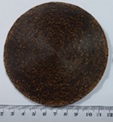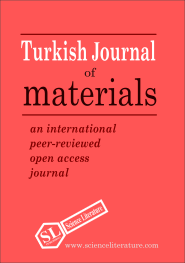
Application oriented recycling and machinability of waste bio-composite materials
Abstract
In this study, waste shell reinforced bio-composite materials were produced, and its machinability behavior was examined to aim the recycle able of waste natural materials and to find new usage fields of waste of natural materials. Waste walnut shell used as reinforcement and epoxy resin were used as a matrix to produce the bio-composite materials. To determine machinability behaviors; drilling, cutting and screw driving tests were performed. Furthermore, the production of tea plates was carried out in order to prove the producibility of the product using walnut shells. It is predicted from the results of these tests that produced bio-composite materials can be used in decoration and coating as an alternative to chipboard and wood. As a result, it has been found that it is possible to recycle wastes such as walnut shells in many areas where plastic or wood and wood products are used, and it is proposed as an alternative material.
Full Text:
PDFReferences
Genç, G., Akkuş, N., and Yalçın, F. Identification the Young’s Modulus of Flax/Epoxy Bio-Composites Materials by Vibration Method. Paper presented at the 7th International Advanced Technologies Symposium (IATS’13), Istanbul, Turkey (2013).
S. Akbaş, T. Güleç, M. Tufan, C. Taşçıoğlu, and H. Peker. Fındık Kabuklarının Polipropilen Esaslı Polimer Kompozit Üretiminde Değerlendirilmesi. Artvin Çoruh Üniversitesi Orman Fakültesi Dergisi, 14(1) (2013) 50-56.
B. Gullu. Odun Kompozitleri. Süleyman Demirel Üniversitesi Orman Fakültesi Dergisi, A(2) (2001) 135-160.
L. Batalla, A.J. Nuñez, and N.E. Marcovich. Particleboards from peanut-shell flour. Journal of Applied Polymer Science 97(3) (2005) 916-923. doi:10.1002/app.21847
A.G. Carvalho, B.G. de Andrade, C.P.T. Cabral, and B.R. Vital. Effect of Adding Yerba Mate Pruning Residues in Particleboard Panels. Revista Arvore, 39(1), (2015) 209-214. doi:10.1590/0100-67622015000100020
M. Gürü, M. Atar, and R. Yildirim. Production of polymer matrix composite particleboard from walnut shell and improvement of its requirements. Materials and Design, 29(1) (2008) 284-287. doi:10.1016/j.matdes.2006.10.023
M. Gürü, S. Tekeli, and I. Bilici. Manufacturing of urea-formaldehyde-based composite particleboard from almond shell. Materials and Design, 27(10) (2006)1148-1151. doi:10.1016/j.matdes.2005.03.003
A.S.O. Mohareb, A.H. Hassanin, A.A. Badr, K.T.S. Hassan, and R. Farag. Novel composite sandwich structure from green materials: Mechanical, physical, and biological evaluation. Journal of Applied Polymer Science (2015) 132(28). doi:10.1002/app.42253
P. Rachtanapun, T. Sattayarak, and N. Ketsamak. Correlation of density and properties of particleboard from coffee waste with urea-formaldehyde and polymeric methylene diphenyl diisocyanates. Journal of Composite Materials, 46(15) (2012) 1839-1850. doi:10.1177/0021998311426624
D.H. Wang, and X.Z.S. Sun. Low density particleboard from wheat straw and corn pith. Industrial Crops and Products, 15(1) (2002) 43-50. doi:Doi 10.1016/S0926-6690(01)00094-2
Copyright (c) 2018 Turkish Journal of Materials

This work is licensed under a Creative Commons Attribution-NonCommercial 4.0 International License.
Indexing:









